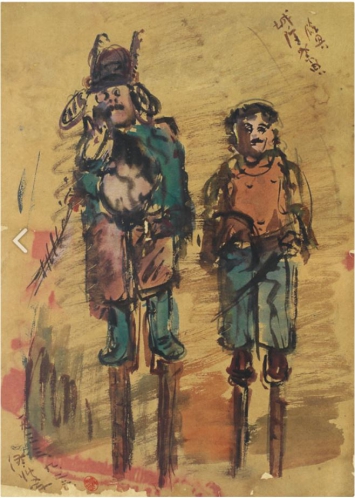城隍祭典
為提供使用者有文書軟體選擇的權利,本文件為ODF開放文件格式,建議您安裝免費開源軟體 ([連結])

城隍祭典-33.9.22
City God Festival-33.9.22
城隍祭典-33.9.22
1933, 紙本淡彩鉛筆, 36.5×26.5cm
watercolor and pencil on paper
紙本淡彩鉛筆
遊行隊伍爆出了熱烈喝采,踩著高蹺的表演者身姿靈動,惹得人們瞪大了眼睛,深怕錯過任何精彩時刻。圍觀群眾總是興奮地昂首張望,而畫家卻低著頭,在紙頁上奮筆疾行。
The crowd bursts into cheers as performers on stilts walk nimbly by. These spectators watch wide-eyed, not wanting to miss a single moment of the excitement. They lift their heads, gleefully watching the parade, but the painter lowers his own, gazing at his pencil as it flits across the paper.
大喝采を巻き起こす祭典の隊列、高蹺(竹馬に似た歩行用具)の演者たちの生き生きとした姿、誰もが目を大きく見開いて、祭りの見せ場を一つたりとも見逃すまいとしています。出し物を取り囲む群衆が興奮気味に四方を見回している間も、画家は視線を画用紙に落として素早く筆を走らせます。
凌亂的鉛筆線條敷上簡單的水彩顏色,便是一幀廟會即景。帶著素描本走進洶湧的人群之中,陳澄波不僅參與了1933年的城隍遶境,也為家鄉風土留下難得的圖像紀錄。
Sketchy pencil marks overlaid with simple watercolors reveal a glimpse of a temple festival. Sketchbook in hand, Chen Cheng-po joined the swelling crowds to take part in the 1933 City God Inspection Tour and created this rare pictorial record of his hometown’s traditional festivities.
ラフな鉛筆画に水彩を用いたシンプルな着色で、祭典の情景が描かれています。スケッチブックを手にして人波に分け入った陳澄波は、1933年に行われた「城隍遶境」に参加しただけでなく、その光景を描いた貴重な絵図を故郷のために残してくれました。

1.陣頭
Dintao (traditional temple performance troupes)
陣頭
遶境隊伍除了「藝閣」還包括各式各樣的「陣頭」。陣頭是深具臺灣味的傳統文化,也是遊行群眾的矚目焦點。其表演內容通常簡單,種類卻相當繁雜。圖中的兩位演員應屬串場的「鬧熱陣」,是遶境主神駕臨之前的暖場節目。
In addition to parade floats, Inspection Tour processions include a wide variety of dintao troupes. These troupes, which hold a special place in traditional Taiwanese culture, are the focal points of the procession. Though their performances are often simple, the repertoire of dintao can vary greatly. The two performers depicted in the painting likely belong to a troupe responsible for energizing the crowd in anticipation of the City God’s arrival.
廟の周囲を練り歩く隊列には、「芸閣」と言われる山車のほかに、様々な「陣頭」も加わります。陣頭は台湾ならではの伝統文化の一つで、祭りの隊列の見どころでもあります。一般に陣頭の芝居や演技はごく単純なものですが、その種類は複雑を極めます。画中の二人は「熱鬧陣」の演者で、主神をのせた神輿が来る前にその場をにぎやかに盛り上げます。
2.布馬陣
Cloth-horse troupe
布馬陣
頭戴狀元帽的男子手持馬鞭,身前懸著突兀的馬頭,旁邊還有一名扈從相伴,顯然是常見於臺灣民俗慶典裡的「布馬陣」。這類趣味性質的劇碼常以一個不諳騎術的狀元或縣官為主角,表演他與隨行人等的笨拙姿態以娛樂觀眾。
Donning the characteristic hat of a scholar and clutching a horsewhip, the Leading Imperial Scholar (Zhuang-yuan) “sits” astride a cloth-horse and is accompanied on foot by a servant. A familiar element in Taiwanese folk celebrations, the cloth-horse troupe delights audiences as they enact the blunders of a clumsy Zhuang-yuan or county magistrate, utterly devoid of horsemanship, and his hapless servants.
状元帽をかぶり、鞭を手にした男性が馬の頭のついたかぶりものを肩に掛けています。傍らには従者の姿も見え、台湾の伝統的祭典で上演される「布馬陣」だとわかります。この種のコミカルな芝居の主人公は馬術が苦手な状元や地方の役人が多く、主役とお供の滑稽な様子が観衆の笑いを誘います。
3.金花
Golden flowers
金花
豎起於帽子兩側的裝飾物應是「金花」,說明了這個角色的身分應是新科狀元。帽上插著御賜金花、在街上風光遊行的狀元郎是常見於民間戲曲中的人物,「狀元遊街」這樣的主題故事,也隨之衍生為「布馬陣」裡的常見戲碼。
Gracing either side of the Zhuang-yuan’s hat are “Golden Flowers,” which denote his recent success on passing the imperial examination. This character—the Zhuang-yuan walking proudly through the streets wearing a hat adorned with golden flowers bestowed by the emperor—has long been popular in traditional folk operas. Tales of Zhuang-yuan promenades are now commonly interpreted by cloth-horse troupes.
帽子の両側に立てられた飾り物は「金花」です。この帽子を見れば、この人物が新しい状元(科挙の首席及第者)だとわかります。皇帝より賜った金花を帽子に挿し、誇らしげに町を練り歩く状元は、民間の芝居によく登場します。「状元遊街」を主題とする物語から、「布馬陣」でよく上演される演目が派生的に誕生しました。
4.高蹺
Stilts
高蹺
參與迎神賽會的陣頭五花八門,若想要與眾不同,踩高蹺或許是個好辦法。「踏蹺陣」通常是獨立的陣頭,圖中的兩名演員屬於講究戲劇表現的「文蹺」,他們可能結合了「布馬陣」的扮相與表演內容,試圖吸引觀眾的目光。
With the wide array of dintao troupes at folk festivals, it can be hard to stand out from the crowd, but walking on stilts does help. Usually, stilt-walking troupes do not intermingle with other dintao in the parade. The two performers in Chen’s painting belong to a “cultural stilts” troupe that presents theatrical performances combining stilt-walking with costumes and storylines used by cloth-horse troupes to captivate the audience’s attention.
「迎神賽会」(廟の祭典の一つ)には多種多様な陣頭が参加します。他との違いを出したければ、「踩高蹺」(竹馬に似た歩行用具を使った陣頭)がいいかもしれません。一般に「踩高蹺」は単独で行われる陣頭で、画中の二人の演者は演劇的な表現を重んじる「文蹺」です。おそらくこの二人は「布馬陣」の扮装や芝居を取り入れて、観衆の注目を集めようとしたのでしょう。
5.書畫展覽會
Painting and calligraphy exhibition
書画展覧会
每年的城隍遶境為嘉義帶來龐大人潮,許多依附性的活動因此衍生,「書畫展覽會」便是一個例子。1933年的嘉義城隍遶境期間,從中國返臺的陳澄波便曾在這類展覽會當中,將他新近完成的上海風景畫呈現在嘉義民眾的眼前。
As the City God Festival continued to draw throngs of visitors to Chiayi year after year, other events, such as the Painting and Calligraphy Exhibition, began to crop up alongside the festivities. Upon returning home from China in 1933, Chen Cheng-po exhibited his recently completed Shanghai landscapes at one such event for the appreciation of Chiayi residents and visitors alike.
毎年、「城隍遶境」の時期には大勢の観光客が嘉義を訪れ、祭典に合わせて様々なイベントが開催されます。「書画展覧会」もそのうちの一つです。1933年に行われた城隍遶境では、中国から帰国した陳澄波もこのような展覧会に出展し、完成後間もない上海の風景画を嘉義の人々に披露しました。
6.淡彩
Watercolors
淡彩画
雖然以油畫知名,但陳澄波其實留下不少作品使用了別的媒材,包括408件的淡彩畫。這批作品湧現於1930年代初期,有相當一部分是他在上海工作期間所完成的裸女畫。除此之外,他也喜歡藉由淡彩來描繪形形色色的人物群像。
Although Chen rose to fame for his oil paintings, he left behind a significant number of works in other media, including 408 watercolor paintings. This body of works dates back to the early 1930s and includes many portraits of female nudes completed during his working sojourn in Shanghai. Other watercolors portray another favorite subject of Chen’s: scenes populated by eclectic multitudes of colorful individuals.
陳澄波は油彩画で名を知られる画家ですが、他の画材を用いた作品も多数あり、それには408点の淡彩画も含まれます。これらの作品は1930年代初期に次々と制作されたもので、上海で働いていた頃に完成させた裸婦画がかなりの部分を占めています。このほかにも、陳澄波は淡彩で様々な人物群像を好んで描きました。
